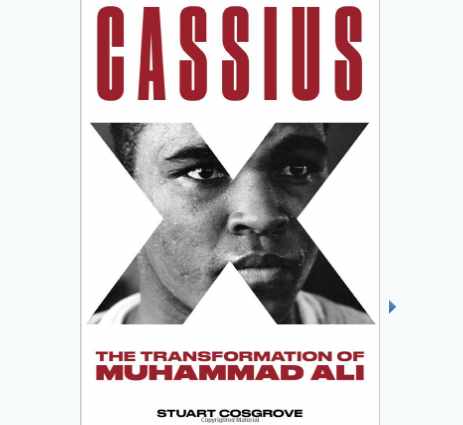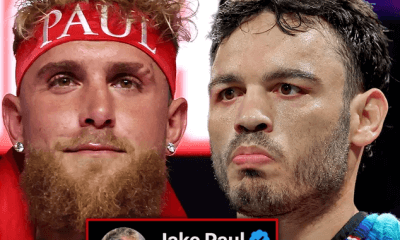Featured Articles
“Cassius X: The Transformation of Muhammad Ali”

BOOK REVIEW by THOMAS HAUSER — Music was the lifeblood of cultural change in the 1950s and 1960s. Cassius X: The Transformation of Muhammad Ali by Stuart Cosgrove (published by Lawrence Hill Books, an imprint of Chicago Review Press) focuses on Cassius Clay’s involvement with the Nation of Islam in the years leading up to his 1964 triumph over Sonny Liston and the expanding reach of what Cosgrove calls “Black music” during that time.
Cassius X is divided into six chapters with a coda entitled “Requiem.” Each chapter is set in a particular city – Miami, Detroit, Philadelphia, New York, London, and Miami again – that was the site for one or more pivotal events in Clay’s life. In each instance, Cosgrove describes Clay’s life and the music scene in that city in depth.
For example, the first chapter (“Miami”) includes a graphic portrayal of racial injustice in the segregated American south as well as Clay’s early involvement with the Nation of Islam and the origins of his friendship with Sam Cooke (a pioneering singer and songwriter of that era). The second chapter (“Detroit”) contains an interesting recounting of a 1962 journey that Cassius, his brother, and Sam Saxon (who introduced Clay to the Nation of Islam) took to Detroit to attend a Nation of Islam rally overseen by Elijah Muhammad and Malcolm X. In “Philadelphia,” the racist underpinnings of Dick Clark’s enormously influential “American Bandstand” television show are explored.
Cosgrove is a Scottish author, journalist, television executive, and TV host with a scholarly interest in music. He’s passionate about his subject and puts words together well. His writing is infused with interesting nuggets of information such as the fact that three records recorded by Sonji Roi (Ali’s first wife) were released after their marriage fell apart. But there are problems with his work.
The biggest problem is that Cassius X is riddled with factual inaccuracies. The red flags begin to appear in the first chapter when Cosgrove writes that Tony Esperti (Clay’s third professional opponent) was “assassinated in a mob hit” in 1967 by a member of the Gambino crime family and adds, “The coroner described it as the perfect execution – a single lethal bullet to the brain.”
“That’s interesting,” I said to myself. I made a note to praise Cosgrove in this review for that bit of information. Then something in the back of my mind cautioned, “Wait a minute!”
Muhammad Ali fought fifty different opponents in his 61 professional fights. I keep a list of which opponents are still alive and the date of death for those who are no longer with us. Tony Esperti died in 2002. I have photographs of him that were taken in 1979. Yet Cassius X dramatically recounts his 1967 “execution” in a Miami steakhouse. In reality, Esperti was the perpetrator of the crime in question.
Unfortunately, there’s more.
Cosgrove writes that “more myths have congregated around Sonny Liston than any boxer before or since.”
I take issue with that. Let’s start with Joe Louis who (among other myths) inspired the allegorical tale of a black prisoner in the moments before his execution crying out “Save me, Joe Louis!” No one is said to have cried out, “Save me, Sonny Liston!”
Cosgrove also writes, “Liston won twenty-six consecutive bouts over five years, and his title-winning victory on September 25, 1962 [over Floyd Patterson] broke the record for consecutive heavyweight victories.”
But Rocky Marciano won 49 fights in a row and retired from boxing with an unblemished record. Joe Louis won 34 fights in a row after his 1936 loss to Max Schmeling. The last time I looked, 49 and 34 were more than 26.
Cosgrove writes that Angelo Dundee “panicked” after Henry Cooper dropped Cassius Clay with a left hook in round four of their 1963 fight. That’s not true. To the contrary, Dundee saw Clay through the crisis.
Similarly, the fatal 1962 encounter between Emile Griffith and Benny Paret is mis-told. After writing that Griffith was “the reigning welterweight champion” at the time (he wasn’t), Cosgrove states that Grffith “lost control” during the final sequence of punches and informs readers, “Referee Ruby Goldstein was tugging at Griffith from behind, pulling him off. As Emile, berserk, struggling passionately in Goldstein’s embrace, was dragged away, Paret, now obviously senseless, crumpled slowly and collapsed.”
That’s inaccurate. All Cosgrove had to do was go to YouTube and watch a video of the fatal round. If he had, he would have seen that Griffith stopped throwing punches and stepped back the moment that Goldstein intervened. Is simple fact-checking too much to ask of a seasoned professional like Cosgrove?
Errors like these make it difficult to know how much of Cosgrove’s factual recitation in other areas (such as music) can be trusted.
Here I might add that Cosgrove writes of a week that the writer Tom Wolfe spent with Clay in 1963 and states, “Wolfe sensed that his simplistic poetry and superficial boasting disguised a deep understanding of business and finance.”
I don’t know what Wolfe “sensed.” I do know that it’s ludicrous to suggest that Clay (or Muhammad Ali) had “a deep understanding of business and finance.”
That brings us to Cassius Clay and the world of music.
Cosgrove equates Muhammad Ali’s ultimate success with the rise of rhythm and blues and (ultimately) hip-hop to become “the preeminent form of popular music in the world.”
Reinterpretations of history are always welcome when solidly grounded. And there’s a lot of interesting information in Cassius X about Clay’s transformation to Muhammad Ali, the Nation of Islam, and the music of that era. But there are times when Cosgrove’s methodology of viewing Clay through the prism of music comes across as forced.
I’m not a scholar with regard to popular music from the 1950s and 1960s. But I know it pretty well, having lived through that time. Lloyd Price and Chubby Checker (acknowledged by Cosgrove to have been important figures during that era) have been guests for dinner in my home. My first real bond with Ali when I began spending time with him while researching Muhammad Ali: His Life and Times (published in 1991) was music.
Muhammad was four years older than I was, but we’d grown up with many of the same songs. We’d drive from the airport to his home in Berrien Springs or be in his car on the way to a restaurant. We’d pop a tape of songs sung by black recording artists into the cassette player and sing along.
“I can’t believe you know all the words,” Muhammad said to me one evening. “I never would have thought it.”
Cosgrove has an impressive resume. Among his many credits, he’s the author of a three-book study of soul music. That said; there are places where he falls victim to hyperbole in advancing his thesis. Twist and Shout, first recorded by the Top Notes and made famous by the Isley Brothers (two black vocal groups) was not “the song the Beatles had become synonymous with” when they came to the United States in 1964. A Christmas Gift for You featuring Darlene Love and the Ronettes was not “one of the greatest pop albums of the era.” It was a celebration of a certain style of music but a repetitive and formulaic compilation. Sam Cooke Live at the Harlem Square Club, 1963 is an excellent recording but not “universally acclaimed as one of the greatest live albums of all time.”
Cosgrove writes that sports columnist Jimmy Cannon “erupted when he learned about the Beatles meeting Cassius in Miami” in 1964 and that Cannon wrote, “Clay is part of the Beatle movement. He fits in with the famous singers no one can hear and the punks riding motorcycles with iron crosses pinned to their leather jackets and Batman and the boys with their long dirty hair and the girls with the unwashed look and the college kids dancing naked at secret proms held in apartments and the revolt of students who get a check from dad every first of the month and the painters who copy the labels off soup cans and the surf bums who refuse to work and the whole pampered style-making cult of the bored young.”
That’s a dramatic quote. But Cosgrove puts it in a misleading context. Cannon wrote those words in 1966 after Ali was reclassified 1-A by his draft board and uttered the words, “I ain’t got no quarrel with them Vietcong.” That was more than two years after Clay met the Beatles.
And Cosgrove writes about Clay’s dalliance with singer Dee Dee Sharp as a serious relationship before characterizing it more accurately as a “brief affair” and then exaggerating its gravitas again.
There’s also some sloppy copy-editing. By way of example, Cassius X states that Sonny Liston refused to allow Liston-Clay I to be shown on closed circuit in theaters in New Orleans “if the seating in New Orleans was not segregated.” I assume that Cosgrove meant “integrated.”
These flaws are disappointing because Cosgrove has a lot to say that’s of interest. At its best, Cassius X contains some very good – even enlightening – material on the evolution of music in the 1950s and 1960s and Cassius Clay’s sojourn through that time.
Thomas Hauser’s email address is thomashauserwriter@gmail.com. His next book – Staredown: Another Year Inside Boxing – will be published by the University of Arkansas Press this autumn. In 2004, the Boxing Writers Association of America honored Hauser with the Nat Fleischer Award for career excellence in boxing journalism. In 2019, he was selected for induction into the International Boxing Hall of Fame.
Check out more boxing news on video at the Boxing Channel
To comment on this story in the Fight Forum CLICK HERE
-

 Featured Articles4 weeks ago
Featured Articles4 weeks agoAvila Perspective, Chap. 330: Matchroom in New York plus the Latest on Canelo-Crawford
-

 Featured Articles3 weeks ago
Featured Articles3 weeks agoVito Mielnicki Jr Whitewashes Kamil Gardzielik Before the Home Folks in Newark
-

 Featured Articles19 hours ago
Featured Articles19 hours agoResults and Recaps from New York Where Taylor Edged Serrano Once Again
-

 Featured Articles4 weeks ago
Featured Articles4 weeks agoCatching Up with Clay Moyle Who Talks About His Massive Collection of Boxing Books
-

 Featured Articles5 days ago
Featured Articles5 days agoFrom a Sympathetic Figure to a Pariah: The Travails of Julio Cesar Chavez Jr
-

 Featured Articles3 weeks ago
Featured Articles3 weeks agoMore Medals for Hawaii’s Patricio Family at the USA Boxing Summer Festival
-

 Featured Articles1 week ago
Featured Articles1 week agoCatterall vs Eubank Ends Prematurely; Catterall Wins a Technical Decision
-

 Featured Articles4 weeks ago
Featured Articles4 weeks agoRichardson Hitchins Batters and Stops George Kambosos at Madison Square Garden




















